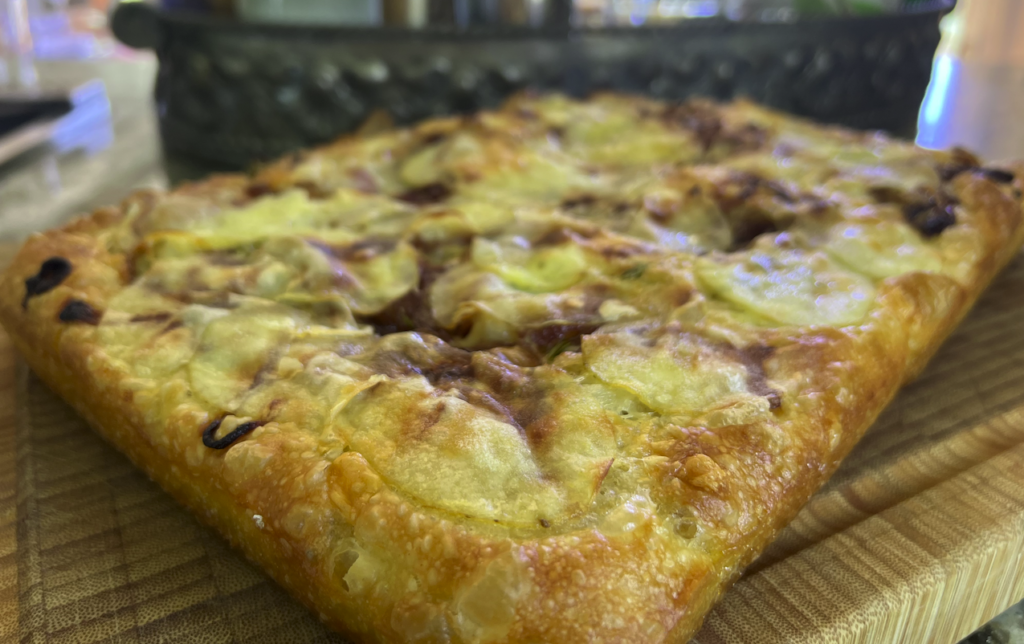Big liner notes on this one, but I promise, the instructions are what makes this easy. This is great for overnight, but it’s also a delicious one you can start at 10am, and bake before 3pm, and be proud of it. I honestly cannot get my life together enough to think about bread a day in advance, but if you can, the bread comes out even better. Special shout out to Ulan for proof-reading this baby.

Pictured is a fontina, carmelized onions, and sliced potatoes with rosemary. Gone in 60 seconds.
The rising times are based upon a warm home, so your times may vary a bit. I use my oven as a proving box (turn on the oven for a couple minutes then turn off so it’s like a hot day in there).
The dough has 5 basic ingredients and we use the “fork kneading” method, which is really cool. The very short version of the instructions is this: (1) mix dry ingredients with water until saturated; (2) transfer to oiled bowl after 1 hour (with fork kneading every 15 minutes); (3) let rise twice for one hour each; (4) transfer to 9X13 oiled pan and let rise for 1 hour; (5) dimple, drizzle with olive oil, decorate and bake at 425 for 30 minutes.
Here are complete instructions:
- 10:00 am. Into a stand mixing bowl, add the following ingredients. If you don’t have a mixer with a dough hook, a regular large bowl will do.
4 cups flour / 515 grams –Bread flour is great for this, but A/P will do very well
2 tsp fine sea salt
2 teaspoons instant yeast - Add 2 cups very warm water and mix with dough hook until fully mixed and there are no dry bits. If you are mixing by hand, use a rubber spatula. Regardless of your method, you will have a pancake batter‑y dough. It’s 89% hydration, so it’s not going to be firm and will not look pretty.
- 10:30am Cover the bowl with plastic wrap or a plastic store bag, or (if you’re not an eco-terrorist) a damp kitchen towel (with a rubber band around it), and let sit for 15 minutes.
[If you plan to bake the bread the next day, place dough in a very well greased plastic container with a lid and refrigerate. I use olive oil – and lots of it – and I also grease the top of the dough. Let sit for 12–48 hours, then skip to step 7]. - Let dough sit out in a warm room and use the fork kneading method to turn the dough on itself, every 15 minutes, for 1 hour. This will make a total of 4 kneads with the fork. Fork kneading: using two fork, go around the bowl, lifting the outside edge of the dough and guide the dough to the center. Do this eight times (takes about 1 minute).
- When you’ve finished the kneading the 4th time, you should see that the dough has lots of yeast striations.
- 11:30am. Grease a clean bowl with olive oil or neutral oil. Scrape your dough into it, rub oil on the top of the dough, and cover. Let rise until double in size. About an hour.
- 12:30 pm. Deflate the dough, and then use the fork kneading method, and let rise again in the bowl, about an hour. If your dough is coming out of the refrigerator, it will probably take 2–3 hours for the same rise.
- 1:30 pm. Liberally oil (and I mean liberally) a 9 x 13 pan with olive oil. Transfer the risen dough to the pan and, stretch it so that it attempts to fill the bottom of the pan (it won’t). Cover pan and let rise one hour. Eventually, the dough will relax and make it to the corners (or you can push it there). In the meantime, prep your toppings, if any.
- 2:30pm Once the dough has risen, and covers the pan, you’re ready to dimple, decorate, and bake. Preheat the over to 425. Grease your fingers and with the tips of your fingers, dimple the dough (like you are playing piano). Drizzle dough with 4 tablespoons of olive oil, press in your ingredients (or just sprinkle with sea salt), and bake for about 25–30 minutes, or until golden. Serve immediately, or let cool, uncovered, then wrap in paper.
Notes:
- If you are going to use cheese along with other ingredients, put the cheese on the dough as the first layer, rather than the last.
- This makes a thick, sandwich style focaccia. If you want thinner, use a cookie sheet.
- The more oil on the bottom, the crispier it will be, but don’t go crazy. If you don’t want to use lots of oil, use parchment paper on the bottom.
- You can put almost anything on focaccia, but watery vegetables make for soggy tops and burnt veggies. Consider roma tomatoes (less water), and drying out things like eggplant and potatoes, before topping them on your dough.
- We tried this at high altitude, and it worked with the following changes: additional ½ cup water; slightly shorter rise times, and greased parchment paper on the bottom.
- Note that I prefer cooked vegetables, but if you like raw, use raw.
- Some of my favorite toppings
- Fontina, caramelized onions, potato, rosemary
- Rosemary and salt
- Shallots and mozzarella
- Pizza style: mozzarella, tomato sauce (or tomatoes), and ricotta
- Sauteed mushrooms and thyme (then dot with gorgonzola when it comes out of the oven.
- Parmesan and herbs.
